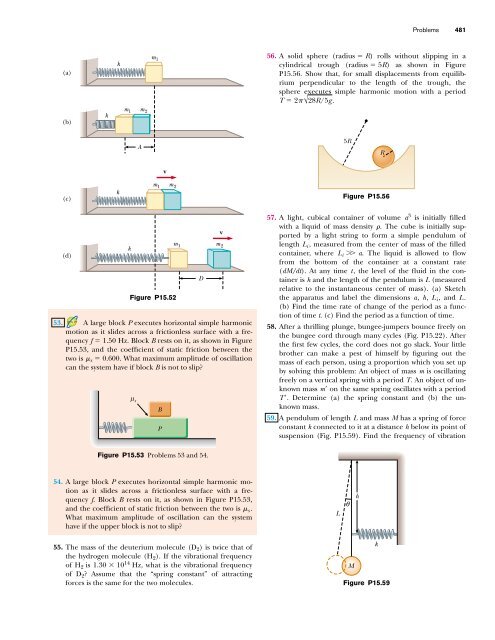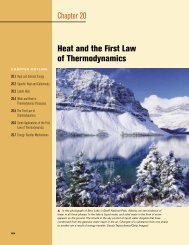15 • Oscillatory Motion - ECHSPhysics
15 • Oscillatory Motion - ECHSPhysics
15 • Oscillatory Motion - ECHSPhysics
Create successful ePaper yourself
Turn your PDF publications into a flip-book with our unique Google optimized e-Paper software.
(a)<br />
(b)<br />
(c)<br />
(d)<br />
k<br />
k<br />
k<br />
m 1<br />
k<br />
A<br />
m 2<br />
m 1<br />
m 1<br />
53. A large block P executes horizontal simple harmonic<br />
motion as it slides across a frictionless surface with a frequency<br />
f 1.50 Hz. Block B rests on it, as shown in Figure<br />
P<strong>15</strong>.53, and the coefficient of static friction between the<br />
two is s 0.600. What maximum amplitude of oscillation<br />
can the system have if block B is not to slip?<br />
v<br />
m 2<br />
Figure P<strong>15</strong>.52<br />
µ µ s<br />
m 1<br />
Figure P<strong>15</strong>.53 Problems 53 and 54.<br />
54. A large block P executes horizontal simple harmonic motion<br />
as it slides across a frictionless surface with a frequency<br />
f. Block B rests on it, as shown in Figure P<strong>15</strong>.53,<br />
and the coefficient of static friction between the two is s.<br />
What maximum amplitude of oscillation can the system<br />
have if the upper block is not to slip?<br />
55. The mass of the deuterium molecule (D 2) is twice that of<br />
the hydrogen molecule (H 2). If the vibrational frequency<br />
of H 2 is 1.30 10 14 Hz, what is the vibrational frequency<br />
of D 2? Assume that the “spring constant” of attracting<br />
forces is the same for the two molecules.<br />
B<br />
P<br />
D<br />
v<br />
m 2<br />
Problems 481<br />
56. A solid sphere (radius R) rolls without slipping in a<br />
cylindrical trough (radius 5R) as shown in Figure<br />
P<strong>15</strong>.56. Show that, for small displacements from equilibrium<br />
perpendicular to the length of the trough, the<br />
sphere executes simple harmonic motion with a period<br />
T 2 √28R/5g.<br />
5R<br />
57. A light, cubical container of volume a 3 is initially filled<br />
with a liquid of mass density . The cube is initially supported<br />
by a light string to form a simple pendulum of<br />
length L i, measured from the center of mass of the filled<br />
container, where L i a. The liquid is allowed to flow<br />
from the bottom of the container at a constant rate<br />
(dM/dt). At any time t, the level of the fluid in the container<br />
is h and the length of the pendulum is L (measured<br />
relative to the instantaneous center of mass). (a) Sketch<br />
the apparatus and label the dimensions a, h, L i, and L.<br />
(b) Find the time rate of change of the period as a function<br />
of time t. (c) Find the period as a function of time.<br />
58. After a thrilling plunge, bungee-jumpers bounce freely on<br />
the bungee cord through many cycles (Fig. P<strong>15</strong>.22). After<br />
the first few cycles, the cord does not go slack. Your little<br />
brother can make a pest of himself by figuring out the<br />
mass of each person, using a proportion which you set up<br />
by solving this problem: An object of mass m is oscillating<br />
freely on a vertical spring with a period T. An object of unknown<br />
mass m on the same spring oscillates with a period<br />
T. Determine (a) the spring constant and (b) the unknown<br />
mass.<br />
59. A pendulum of length L and mass M has a spring of force<br />
constant k connected to it at a distance h below its point of<br />
suspension (Fig. P<strong>15</strong>.59). Find the frequency of vibration<br />
L<br />
R<br />
Figure P<strong>15</strong>.56<br />
θ<br />
M<br />
h<br />
k<br />
Figure P<strong>15</strong>.59



